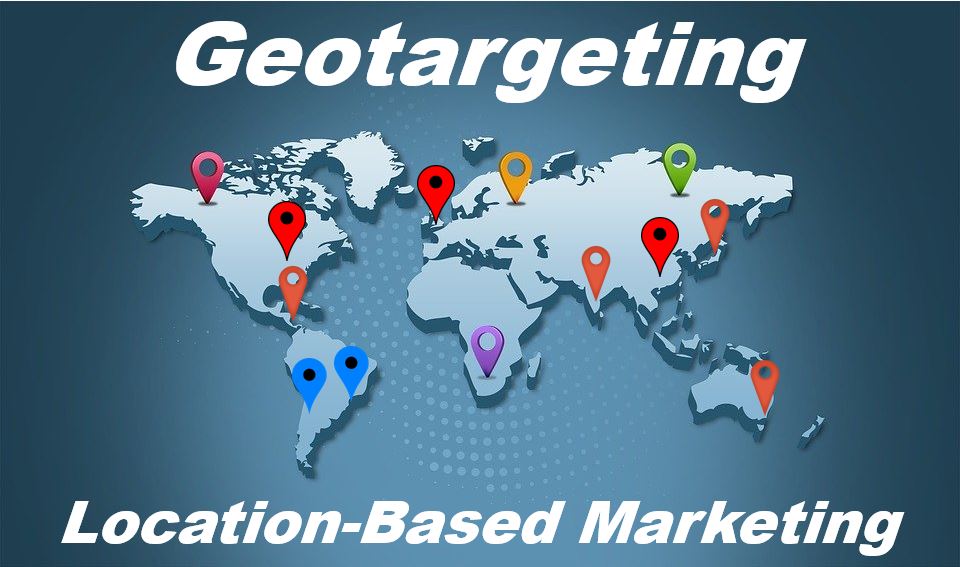Geotargeting or location based marketing refers to targeting people with, for example, advertising material according to where they are, i.e., their geographical location. If your marketing material is tailored according to where the consumer lives or works, it will be more relevant or interesting for them. If something is more interesting, they are more likely to read it, and ultimately, become paying customers.

TechTarget has the following definition of the term:
“Geotargeting is the practice of customizing an advertisement for a product or service to a specific market based on the geographic location of potential buyers.”
“Every country, province, state, county or city in the world can constitute a niche market for certain products or services at certain times.”
Thanks to geotargeting, small companies today can compete effectively in markets that historically have been dominated by large corporations. This is one of several examples of new technology leveling the playing field in the world of business.
Geotargeting vs. blind advertising
Blind advertising involves placing ads regardless of who the readers or viewers of a website, newspaper, outdoor banner, or billboard are.
If you can target your ads geographically, your marketing or advertising ROI is likely to be considerably greater than if you opted for blind advertising. The letters ROI stand for return on investment.
In eCommerce, the click-through rates of geotargeted ads are always superior to their non-geotargeted messages. The click-through rates are better because you have personalized the marketing content, which increases engagement. Whatever you message is, as far as the reader, viewer, or listener is concerned, is locally relevant.
GoundTruth.com makes the following comment regarding tailoring your messages according to where consumers are:
“In a nutshell, geotargeting helps advertisers create more relevant, targeted promotions for consumers, resulting in increased engagement.”
Let’s suppose you have a business that sells gloves and scarfs in North America, South America, and Europe. Your target consumers are people who need to stay warm when they go out because the weather is cold. Therefore, you need to focus on people in late autumn or during the winter. You are not going to target consumers when it is hot outside.
Therefore, you will advertise in North America and Europe from about October to the middle or end of February. You should target South American consumers, especially those with cold winters, i.e., Chileans, Uruguayans, and Argentinians, from about mid-April to the beginning of September.
Your advertising/marketing return on investment will be much greater than if you advertised everywhere all year round. By limiting your adverts to people at certain times of the year according to where they live, you are geotargeting.
The Internet has changed marketing techniques
Before the advent of the Internet, how we worked, played, gathered information, studied, shopped, socialized, and communicated was very different. Marketing is no exception.
A few decades ago, geotargeting was the domain of direct mail companies and TV, radio, and printed newspaper advertisers. There was no marketing of companies, products, services, or brands using digital technologies such as the Internet, i.e., digital marketing did not exist.
Today, with personal computers, smartphones, and the Internet, geotargeting includes accumulating information from IP addresses and mobile location data. Through cell tower triangulation it is also possible to gather relevant data.Currently, more and more property owners are realizing that leasing a cell tower is a huge opportunity given the fact that the more profitable the tower becomes, the more income they earn! In fact, property owners can benefit from a solid cell tower income for decades to come.
Marketing professionals now use mobile advertising and geofences to reach their target audiences based on where they currently are to serve advertisements in real time. It is even possible to serve adverts later using people’s previous locations. Geofencing refers to a location-based service that marketing professionals use by sending specific messages to mobile phone users who enter a geographic area.
What are the benefits of geotargeting?
- A better user experience.
- It is an effective way of spreading information to local audiences regarding discounts, offers, etc.
- Marketers can use personalized messages which increase engagement.
- The ads are relevant and useful to the targeted users.
- There is a better ROI on money marketers spend on advertising.
- Companies can hide their strategic adverts from rivals.
- It helps you build authority as the go-to place in a particular neighborhood.
- You soon get to know what the best and worst performing areas are.
- If your posts a locally revelant, you are more likely to build customer or brand loyalty.
